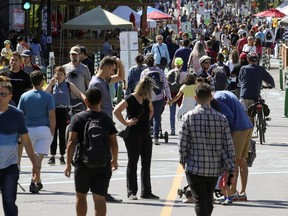While Plateau-Mont-Royal Mayor Luc Rabouin extols the project’s success, not all merchants welcome closing the streets to vehicles.

With summer winding down, Montrealers were walking, cycling and using scooters on Mont-Royal Ave. Thursday afternoon, with the closure of part of the street to all cars extended until October this year.
Rabouin said the city wants to go even further on pedestrianization, with more money dedicated to projects and more predictability. The Plante administration will announce Friday morning that it will renew the pedestrianization of all nine streets that were closed this year for a three-year period starting next year. The streets designated pedestrian only are: Mont-Royal Ave., Duluth Ave., De Castelnau St., Wellington St., Ontario St. E, St-Denis St., Ste-Catherine St. E., St-Hubert St. and Bernard St. The city is also almost doubling the funding available to the merchants associations to put together the pedestrian-only zones, to $700,000 per year from $375,000.
Alia Hassan-Cournol, an associate executive committee member handling economic development, said adding predictability, rather than announcing the streets every year, will help businesses. The new money will allow local businesses to hire liaison agents to prepare the streets several months in advance, and will allow the associations to conduct impact studies. The city is also adding $1.1 million per year to support new pedestrian zones on other roads. Overall, the city will spend $12 million for three years for pedestrian streets, up from $10 million for the previous three-year period.
“Pedestrian roads have entered into our DNA,” Hasan-Cournol said. “Can you imagine a summer without strolling on Mont-Royal, stopping for a drink or an ice cream with the kids? Pedestrian-only streets are also a way to give our citizens access to culture and leisure during a summer when they may not be able to afford to leave on vacation.”
“That speaks to the success of the project,” said Rabouin, who is also Mayor Valérie Plante’s point person in charge of economic development.
There are still challenges, said Claude Rainville, the director general of the Mont-Royal Ave. merchants association. Among them, access to the street and its shops for those with mobility issues, like people in wheelchairs, walkers or those who walk with canes.
Among the issues are access to the Mont-Royal métro station and the 97 bus, which runs along Mont-Royal for most of the year, but on St-Joseph St. when the avenue is closed.
The borough offers an emission-free bicycle taxi for those who need it, and other arrangements are also being made, Rabouin said, but he admits there can be improvements in that area.
“We can’t let anyone be left behind,” Rainville said, “whether they are people with reduced mobility who need access to public transit, or certain businesses who are destination stores that don’t welcome these kinds of projects.”
Rainville hopes the city’s three-year commitment will help local merchants groups develop longer-term solutions for these type of challenges. He said the three years will also allow the association to plan projects further in advance, and to order street furniture that can stay in place for longer periods of time.
Not all merchants welcome the closure of the street.
“To be honest, it’s not very good for us,” said Aziz Ahmed, the owner of the clothing store Boutique Maha Lakshmi and the furniture and decor store Bouddha Art. “My space is all taken up by the bar.”
He explained that Bouddha Art is located right behind the Bily Kun terrasse, which reduces the visibility of the store. Boutique Maha Lakshmi is located right next to the same terrasse, and often that is where people who are not permitted to smoke will stand on the street or sidewalk to light up their cigarettes, rendering his storefront uninviting.
Ahmed has complained to the borough, but his emails have not been returned. Now he’s considering shuttering one or even both of his stores in the coming months
A survey done by the merchants association last year showed 46 per cent of respondents said the project helped their annual bottom line, while 30 per cent said it hurt their business. The rest said they noticed no change.
Rabouin said the results on the street speak for themselves in terms of the sheer number of people who seek out pedestrian streets.
“I remember clearly there was an instance where it was raining all day, a heavy downpour. Five minutes after the rain stopped, the street was totally packed with people,” he said. “It’s true that not everyone benefits, but we bring the people to the street; that’s our job, then it’s up to merchants to work so that people enter their establishments.”